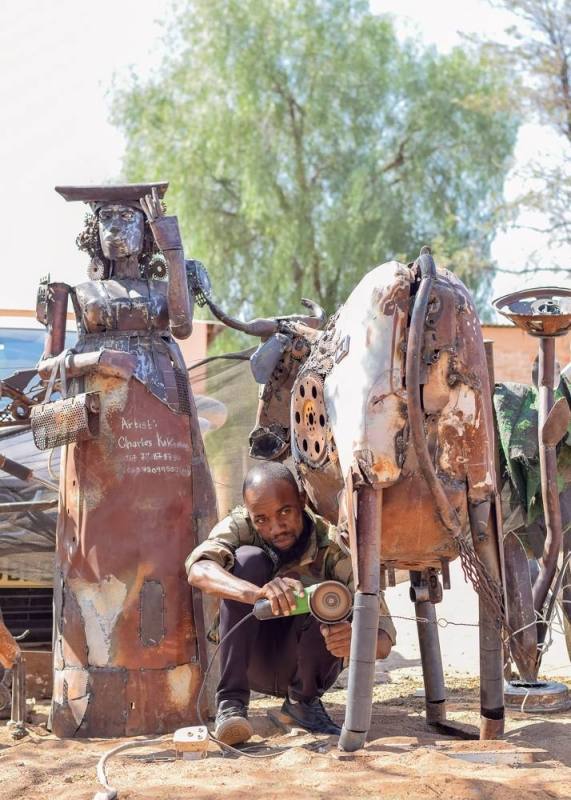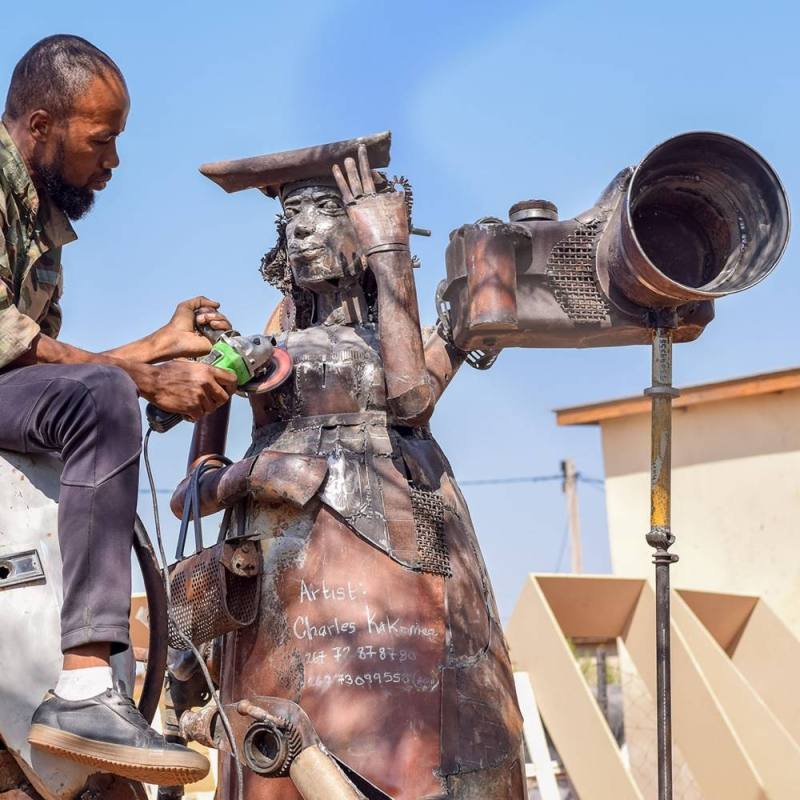A multi-faceted visual artist, Charles Kakomee-Tjeja was one of the first local artists who showcased their works at the just ended Makgadikgadi Epic extravaganza. His spellbinding pieces were one of the major attractions at the 1km space which was specially reserved for visual artists, including pottery, graffiti, beadwork, fashion designs and photography.
On a positive spin, his work is making the right waves and he has enquiries from Namibia, and as far as Netherlands, where interested clients are looking into commissioning him to do various pieces. The exhibition was titled ‘Art of the Pans’ exhibition. The event provided many with a first chance to learn and hear about this incredible artist when the CEDA ambassador, Sonny Serite posted about how he had purchased a camera sculpture made from recycled metal. The artist has a soft sport for cameras.
A few years ago, he lost his precious camera hence he decided to pour his love into these two pieces. The camera is also significant of how in the olden days, people would pray before they started eating unlike now when they rush for their phones to capture the first picture before they eat. These two famous pieces are not the only items which he was showcasing. The Kereng born artist also illustrated the transformative beauty of metal through a very alluring Mbanderu woman. And as it is always the case, there is a story with this piece, and how he came to breathe life into it.
Speaking in an interview with this publication, he explains that he worked as an Art teacher for a few years, but soon felt that the classroom was not challenging him enough. He explains that he felt that the walls of the classroom were too small for him hence he chose to pursue something that lights up his heart, and also inspire the world with his array of art pieces. He notes that as an artists who is skilled in various disciplines of the visual arts, recently ventured into sculpting. He shares that in the series of metal sculptures that he recently ventured into, three of them stand out. These he says, includes the live sized woman figures, larger-than-life camera sculptures and a cow. “All of this are purposely themed as influenced by my life and yours.
These metal sculptures are all made of scrap metal destined for scrap yard and some which are just an eyesore to the environment,” he explains. He starts off by explaining that the first piece happens to be Mukaa Kotjitenda- which loosely translates to a woman of metal or one who is married to Metal. It is a series of sculptures showing life sized figures of women wearing a traditional attire known to ovaHerero and ovaMbanderu communities. “These sculptures show the strength and resilience of an African woman. More especially owing it to my native Mbanderu and Herero communities who survived the 1st century genocide by Germany on the then South West Africa and now Namibia, 120 years ago,” he explains. He also notes that there is the exaggerated camera sculptures dubbed: “Lense and lies”.
These were inspired by the picture perfect life style that everyone is trying to portray on social media. According to Tjeja, society lives a life where there are cameras everywhere; in our phones, cars, houses, cars and streets. The revolution on a camera has made our world as small as the palms of our hands. “I feel like it has made us drift away from humanity and lack of appreciation to the true meaning of life,” he explains. And then there is also the sculpture of “Kahirona” the cow which cements and celebrates as a symbol of wealth and economic back of most African communities.
He also explains that he chooses not to paint his works. Simply because, he intentionally wants to highlight the fact that even though those pieces of scrap metals have been exposed to various weather elements, when joined together, they create a piece of art which one gets to appreciate. “We may have faced some hardships in certain phases of our lives but when we put those charters together, so are the days of our lives,” he says.
For the Mukaa Kotjitenda sculpture, he says that all the pieces communicated with him: "I mostly used a car door," he says. This particular piece, which was recently on special for P15 000, weighs 35kg. He further says that he decided to celebrate women from his culture, as he has seen sculptures of San people but not his people hence this tribute.
On a positive spin, his work is making the right waves and he has enquiries from Namibia, and as far as Netherlands, where interested clients are looking into commissioning him to do various pieces. The exhibition was titled ‘Art of the Pans’ exhibition. The event provided many with a first chance to learn and hear about this incredible artist when the CEDA ambassador, Sonny Serite posted about how he had purchased a camera sculpture made from recycled metal. The artist has a soft sport for cameras.
A few years ago, he lost his precious camera hence he decided to pour his love into these two pieces. The camera is also significant of how in the olden days, people would pray before they started eating unlike now when they rush for their phones to capture the first picture before they eat. These two famous pieces are not the only items which he was showcasing. The Kereng born artist also illustrated the transformative beauty of metal through a very alluring Mbanderu woman. And as it is always the case, there is a story with this piece, and how he came to breathe life into it.
Speaking in an interview with this publication, he explains that he worked as an Art teacher for a few years, but soon felt that the classroom was not challenging him enough. He explains that he felt that the walls of the classroom were too small for him hence he chose to pursue something that lights up his heart, and also inspire the world with his array of art pieces. He notes that as an artists who is skilled in various disciplines of the visual arts, recently ventured into sculpting. He shares that in the series of metal sculptures that he recently ventured into, three of them stand out. These he says, includes the live sized woman figures, larger-than-life camera sculptures and a cow. “All of this are purposely themed as influenced by my life and yours.
These metal sculptures are all made of scrap metal destined for scrap yard and some which are just an eyesore to the environment,” he explains. He starts off by explaining that the first piece happens to be Mukaa Kotjitenda- which loosely translates to a woman of metal or one who is married to Metal. It is a series of sculptures showing life sized figures of women wearing a traditional attire known to ovaHerero and ovaMbanderu communities. “These sculptures show the strength and resilience of an African woman. More especially owing it to my native Mbanderu and Herero communities who survived the 1st century genocide by Germany on the then South West Africa and now Namibia, 120 years ago,” he explains. He also notes that there is the exaggerated camera sculptures dubbed: “Lense and lies”.
These were inspired by the picture perfect life style that everyone is trying to portray on social media. According to Tjeja, society lives a life where there are cameras everywhere; in our phones, cars, houses, cars and streets. The revolution on a camera has made our world as small as the palms of our hands. “I feel like it has made us drift away from humanity and lack of appreciation to the true meaning of life,” he explains. And then there is also the sculpture of “Kahirona” the cow which cements and celebrates as a symbol of wealth and economic back of most African communities.
He also explains that he chooses not to paint his works. Simply because, he intentionally wants to highlight the fact that even though those pieces of scrap metals have been exposed to various weather elements, when joined together, they create a piece of art which one gets to appreciate. “We may have faced some hardships in certain phases of our lives but when we put those charters together, so are the days of our lives,” he says.
For the Mukaa Kotjitenda sculpture, he says that all the pieces communicated with him: "I mostly used a car door," he says. This particular piece, which was recently on special for P15 000, weighs 35kg. He further says that he decided to celebrate women from his culture, as he has seen sculptures of San people but not his people hence this tribute.









